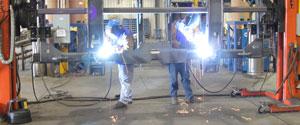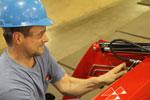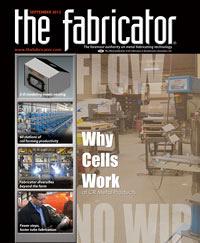Senior Editor
- FMA
- The Fabricator
- FABTECH
- Canadian Metalworking
Categories
- Additive Manufacturing
- Aluminum Welding
- Arc Welding
- Assembly and Joining
- Automation and Robotics
- Bending and Forming
- Consumables
- Cutting and Weld Prep
- Electric Vehicles
- En Español
- Finishing
- Hydroforming
- Laser Cutting
- Laser Welding
- Machining
- Manufacturing Software
- Materials Handling
- Metals/Materials
- Oxyfuel Cutting
- Plasma Cutting
- Power Tools
- Punching and Other Holemaking
- Roll Forming
- Safety
- Sawing
- Shearing
- Shop Management
- Testing and Measuring
- Tube and Pipe Fabrication
- Tube and Pipe Production
- Waterjet Cutting
Industry Directory
Webcasts
Podcasts
FAB 40
Advertise
Subscribe
Account Login
Search
From the farm to oilfields, mines, heavy equipment, and more
Iowa fabricator expands beyond agriculture
- By Tim Heston
- September 3, 2012
- Article
- Shop Management
Ida Covi spent years in executive management positions. She headed a venture capital firm, oversaw diverse investment portfolios, and worked in mergers and acquisitions, shepherding transactions for pharmaceutical firms as well as manufacturers. Earlier this year she met with Allen Mahaney, chairman of Radius Steel Fabrication-SOO Tractor, about coming onboard as CEO of the Radius Steel business unit to lead the company’s diversification efforts. Right then her life was about to change.
The 100-employee fabricator in Sioux City, Iowa, has long been associated with the agricultural sector. Its history goes back to some quintessential farm implements that helped shape agriculture in the heartland. The company got its start producing sweep forks for hay, and over the years it has produced products for some classic farm brands, Massey Ferguson® and Hesston® among them.
Most salaried personnel have been with the company between 10 and 18 years, and the average hourly worker has worked at the fabricator for more than a decade. “A lot of people have been here more than 30 years,” Covi said. “Mahaney doesn’t put corporate greed in front of employees. There’s a sense of social responsibility. That’s why there’s loyalty here.”
These employees have served some longstanding customers. The firm has been a key AGCO supplier for years. And now the manufacturer is undergoing a major rebranding effort. Earlier this year the firm changed its name from SOO Tractor (a name with obvious agricultural connections) to Radius Steel Fabrication-SOO Tractor. The fabricator has served sectors outside agriculture for years, but the work has represented a relatively small part of the business. Today Radius remains a key supplier in the agricultural supply chain, but it’s now venturing outside the farm more than ever—to industries like oil and gas, mining, construction equipment, and others.
Fabrication, Coating, Assembly
The company receives most of its steel from five local laser cutting houses that can deliver extremely quickly, sometimes within a day or so. And there can be quite a mix of orders: hay accumulators, 50-ft. air drills, 120-ft. agricultural sprayers, front-end loaders, lift axles, and side-dump trailers. During a given day, the fabricator’s two Sioux City plants—the original plant on West 1st Street and a newer facility on Hawkeye Drive—could be processing any of these and others.
Most bending, welding, and grinding take place in the West 1st Street plant, the principal fabrication facility. (The company is in the process of acquiring the stringent CSA 47.1 certification from the Canadian Welding Bureau, a credential that will help the company expand into new markets.) Backhoe products and front-end loaders are powder-coated and assembled at West 1st, while accumulators and other, larger products head to the Hawkeye facility, which has a larger powder-coat booth and an extensive assembly area (see Figures 1-3).
Radius also has five powder-coat lines. One of them is the largest of its kind in the region. Thanks to a five-stage parts-washing system and speedy infrared booster oven, the line can process parts at 14 feet a minute, depending on what’s hanging. Seven years ago the company coated at only half that rate. The fabricator’s line can handle parts up to 5 ft. wide, 8 ft. high, and 25 ft. long (see Figure 4).
Scheduling to Meet Demand
Plant Manager Michael Felts pulled out an order sheet from AGCO for the DL100, a popular front-end loader. “This is today’s order sheet,” he said. “I’ve got a large order over the next three months.”
Felts, working closely with company President Dexter Schaible, must weigh that demand against the number of loaders the company has in inventory, and then plan the production schedule to suit. Since Radius Steel-SOO has been producing for AGCO for so many years, the two companies share a fair amount of information. They have to, with a global supply chain to juggle. For consistency, the fabricator uses the same approved suppliers as its OEM customers.
Every day Felts and Schaible receive a report for future orders, but when will the customer pull the trigger for those orders and request immediate delivery? They have a good idea. After decades of working with the customer, they know which products sell fast and which don’t. So they schedule enough to meet demand, but make sure not to overproduce.
Once the customer pulls the trigger for, say, a certain number of front-end loaders, shipping department workers transport finished products to rectangles painted on the floor. Each rectangle is one tractor-trailer load. The trucks then deliver products to the port, where the AGCO tractors shipped from other countries are sitting. The loaders then are assembled to the tractors at AGCO’s port facility, and from there they ship off to dealers.
“It’s a bit of a guessing game,” Felts conceded, “but it’s a guessing game that works really well.”
Yes, the shop may have varying levels of finished-goods inventory and deal with some scheduling uncertainties. But these are similar risks many suppliers face these days, post-Great Recession, with so many major OEMs pushing inventory demands down the supply chain.
The fabricator’s major customers benefit from just-in-time delivery, while Radius Steel-SOO benefits from long-term customer relationships. As evident by the company’s longevity, those long-term customer partnerships have paid off. Covi added that such collaboration and reliability (the company’s warranty rate is well less than half of 1 percent) are helping the firm as it expands to other markets.
The Importance in Diversity
The diversification strategy has had early successes. Since April the company has landed contracts with companies like SmithCo. Mfg., a Le Mars, Iowa, maker of side-dump trailers. In the spring it landed a contract to produce lift axle components for Silent Drive Inc., an Orange City, Iowa, manufacturer. At this writing, another large client in the heavy construction arena just came onboard.
The company doesn’t want to be all things to all people. That’s why managers aren’t pursuing small, one-time, piece-part orders—10 of this, 20 of that. The growth strategy instead centers on bringing in long-term customers from various sectors.
The fabricator does not specialize in piece-part work. Instead, almost all revenue comes from comprehensive projects. One hay accumulator model entails 1,779 pieces, and company personnel manage the sourcing, fabrication, welding, coating, and assembly of all of them.
That, Covi said, remains Radius Steel’s sweet spot.
The Radius Transition
Bob Coacher has an apt surname. The account manager works for the Center for Industrial Research and Service (CIRAS), a research arm of Iowa State University Extension and Outreach, which offers business consulting services to Iowa companies. CIRAS (www.ciras.iastate.edu) consultants like Coacher offer services to manufacturers, with the hope that they stay and grow in Iowa.
Years ago Coacher met Allen Mahaney, chairman of Radius Steel Fabrication-SOO Tractor, at a Sioux City industrial roundtable meeting. At the time Mahaney was looking for help with ISO certification. During his first plant tour several years ago, Coacher saw how far the company had already come. “They have good communication links between purchasing, design, and production,” Coacher said. “And if necessary, they analyze and document a new process if they see something that’s affecting lead-time. They have a very good system.”

Figure 2: The company outsources most of its cutting work to local laser cutting houses. From there the blanks are routed through bending and to other processes downstream.
Today Coacher is helping the company implement some continuous improvement practices, borrowing concepts from lean manufacturing and adapting them to the fabricator’s manufacturing environment. He said that the company’s part flow is managed well, especially considering its highly various product mix. Even the welding areas and powder-coat lines don’t have extensive work-in-process in front of them.
“The owners have been great about investing in equipment to open those bottlenecks,” said Plant Manager Michael Felts.
The next step, Coacher said, will be to adapt manufacturing flow for the diverse work coming in from the company’s expansion efforts. Although workflow suits the company’s current product mix, it may need to adapt as the product mix changes. Will lean manufacturing cells work for certain products? Will alternative machine layouts for bending, welding, and grinding minimize work-in-process travel between the company’s two manufacturing facilities?
At this point, Coacher said, all these ideas are preliminary. One thing is for sure, though: The product mix is evolving, and the shop floor will evolve with it.
About the Author

Tim Heston
2135 Point Blvd
Elgin, IL 60123
815-381-1314
Tim Heston, The Fabricator's senior editor, has covered the metal fabrication industry since 1998, starting his career at the American Welding Society's Welding Journal. Since then he has covered the full range of metal fabrication processes, from stamping, bending, and cutting to grinding and polishing. He joined The Fabricator's staff in October 2007.
subscribe now

The Fabricator is North America's leading magazine for the metal forming and fabricating industry. The magazine delivers the news, technical articles, and case histories that enable fabricators to do their jobs more efficiently. The Fabricator has served the industry since 1970.
start your free subscription- Stay connected from anywhere

Easily access valuable industry resources now with full access to the digital edition of The Fabricator.

Easily access valuable industry resources now with full access to the digital edition of The Welder.

Easily access valuable industry resources now with full access to the digital edition of The Tube and Pipe Journal.
- Podcasting
- Podcast:
- The Fabricator Podcast
- Published:
- 04/16/2024
- Running Time:
- 63:29
In this episode of The Fabricator Podcast, Caleb Chamberlain, co-founder and CEO of OSH Cut, discusses his company’s...
- Trending Articles
AI, machine learning, and the future of metal fabrication

Employee ownership: The best way to ensure engagement

Steel industry reacts to Nucor’s new weekly published HRC price

Dynamic Metal blossoms with each passing year

Metal fabrication management: A guide for new supervisors

- Industry Events
16th Annual Safety Conference
- April 30 - May 1, 2024
- Elgin,
Pipe and Tube Conference
- May 21 - 22, 2024
- Omaha, NE
World-Class Roll Forming Workshop
- June 5 - 6, 2024
- Louisville, KY
Advanced Laser Application Workshop
- June 25 - 27, 2024
- Novi, MI





























